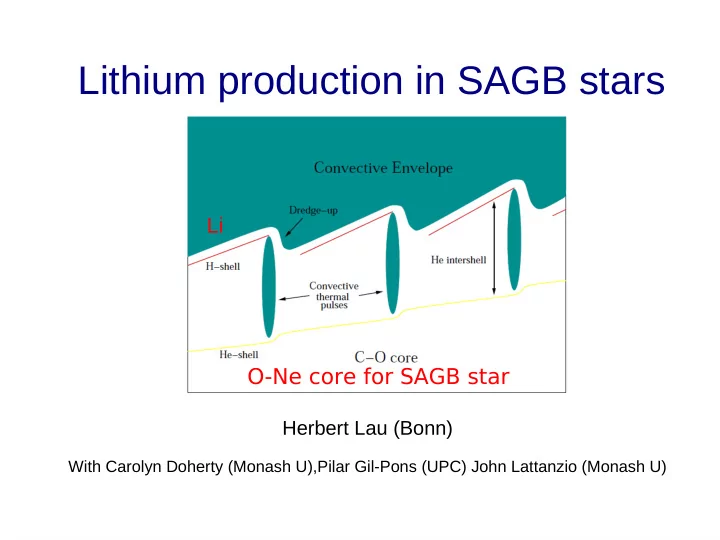

Lithium production in SAGB stars Li O-Ne core for SAGB star Herbert Lau (Bonn) With Carolyn Doherty (Monash U),Pilar Gil-Pons (UPC) John Lattanzio (Monash U)
Outline SAGB stars and Li production Codes and input physics Exploration of effects Initial mass and metallicity Mass loss rates Mixing length parameter Conclusions
SAGB stars & Li production SAGB stars: hot enough to ignite carbon at the early AGB phase. mass range: ~7 to ~10 M sun Hot bottom burning: Bottom of convective envelope > 60 million K. Li is created during HBB via Cameron & Fowler (1971) mechanism. He3+He4->Be7, Be7+e-> Li7 There is only a short period of time in which Li is enhanced in the surface. Li abundances then go down due to depletion of 3 He Previous work for Z=10 -3 by Ventura and D'Antona (2010)
Our codes & input physics Monash version of the Mount Stromlo stellar evolution program (MONSTAR), -see Doherty et al. (2010) for published model of SAGB stars. The nucleosynthesis was performed using a post processing code with a 77 species network. Standard mass loss rate is Vassiliadis & Wood (1993). Other mass loss rates: Bloecker (1995), van Loon et al (2005) & Reimers (1975) are also considered.
Our codes & input physics Mixing length parameter α is set to 1.75 Other mixing length parameters are also investigated No extra mixing / cool bottom process used Initial Li is set to be [Li/Fe]=0 for solar, LMC, SMC log ε Li =2.176 for lower metallicity. Yield for isotope X are calculated by: (surface abundance of X – initial abundance of X) x mass loss rate, throughout the evolution
Production factor for solar, LMC, SMC compositions
Production factor for Z=10 -3 , Z=10 -4
Analysis of results General trend with initial mass and metallicity Effects of the mass loss rates Effects of the mixing length parameter α
Trend of Li yields with Z, M 0 z=0.008 z=0.004 Z=0.02 z=0.001
Trend of Li yields with Z, M 0 Z=0.02 Z=0.008 Z=0.004 Z=0.001 7.5 M sun 8.0 M sun 8.5 M sun 9.0 M sun
Average abundance in the ejecta
Mass trend More massive SAGB stars produce more Li because the early TP-SAGB temperatures in the base of their convective envelopes are higher (more efficient HBB). This leads to a higher peak of Li abundances . Although the high Li phase is shorter, the early mass loss rates are higher . The less massive AGB stars (<7M) don't have positive yield, although some of them have a small period that Li is enhanced in the surface.
Metallicity trend Two competing effects: The temperatures at the base of the convective envelopes are higher for lower metallicity stars, so less massive AGB stars also produce Li at low Z. At the same time the early mass-loss rate at lower metallicity is lower, so it is harder to extract Li before depletion. => For the same initial masses Li yields increase with decreasing Z => Higher Z stars make more Li overall
Effects of the mass loss rates
Effects of mass loss rates and α 8.5 M Z=0.02. Evolution of surface abundances. Effects of the mass loss rate & mixing length parameter.
Effects of mass loss rates and α 8.5 M Z=0.02. Yields. Effects of the mass loss rate & mixing length parameter.
Effects of mass loss rates and α Peak log ε Li can be as high as 4.3 . For the same initial masses Li yields increase with decreasing Z Li is enriched at the surface for a brief period of time in the early TP-SAGB. Therefore higher mass loss rate at this phase can extract much more Li. If mass is tranferred to a companion star at this time, the surface of this companion star would be significantly enhanced in Li. Increasing the mixing length parameter actually decreases the Li yields because the Li peaks for a shorter time, even when the temperature at base of convective envelope is higher.
Conclusions Li yields are highly dependent on the mass loss rates. Rapid mass loss rates lead to significant enhancement of Li. The presence of a close companion might strip off the envelope at the early AGB and lead to the enrichment in Li of the accreting star. The scatter of Li yields for different initial masses tends to increase with decreasing Z. For the same initial masses Li yields increase with decreasing Z. Higher Z stars make more Li in total.
Recommend
More recommend